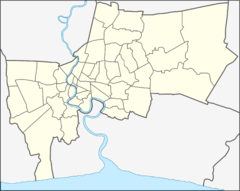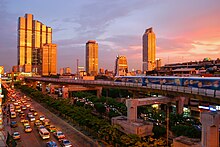Wat Yannawa
| Wat Yannawa | |
|---|---|
วัดยานนาวา | |
 Chinese Junk Chedi (Phra Samphao Chedi) of Wat Yannawa | |
| Religion | |
| Affiliation | Theravada Buddhism |
| Location | |
| Location | Charoen Krung road Khwaeng Yannawa, Khet Sathorn, Bangkok, Thailand |
| Country | Thailand |
 Shown within Bangkok | |
| Geographic coordinates | 13°43′02″N 100°30′49″E / 13.7173°N 100.5136°ECoordinates: 13°43′02″N 100°30′49″E / 13.7173°N 100.5136°E |
Wat Yannawa (Thai:วัดยานนาวา, RTGS: Wat Yannawa, commonly known in English as “The boat temple”, is a Buddhist temple (Wat) in Bangkok on Charoenkrung Rd, Sathorn district. This temple has a long history from the Ayutthaya era to the present. During the reign of King Rama I, the ubosot was built and named "Wat Yannawa". Then, King Rama III built a temple building in the shape of a Chinese junk ship, giving the temple the nickname the "boat temple". The part of architecture inside of this temple is about the room that people pray, ubosot that enshrined the Buddha images and the pictures that draw in the style of “Loi Prathip Royal Lantern Festival” (Thai:พระราชพิธีลอยพระประทีป). The part of architecture outside is about the building that enshrined Buddha relic from Sri Lanka and has the Goddess of Mercy in front of the building.
Gallery[]

One of the minor Chedis on the Junk Chedi

The Junk Chedi before a major renovation

Wat Yannawa Museum building

Walking Buddha statue

King Rama III sculpture standing in front of the Junk Chedi

Another minor Chedi on the Junk Chedi decorated with flags
History[]
Building in Ayutthaya Era since the nineteenth century this temple is called Wat Kok Khwai [1](Thai:วัดคอกควาย). During King Nangklao or King Rama III viharn was build in Chinese junk ship and renewd to be Wat Yannawa by this name mean “the boat temple”.[1] In the past this temple named as Wat Kok Khwai because people around here had an activity that buy-sell buffalo in here then this temple changed named again to be Wat Kok Krabue (Thai:วัดคอกกระบือ).Since established to be the royal temple in King Rama I and build ubosot after that changed name to be “Wat Yannawa”.[2] The two chedis on deck represent the masts and the altar at the back because of this the people around there call this temple “sampao chedi”.[3] For reason why King Rama III build Chinese junk ship because in the past when people traded with abroad usually use Chinese junk but at that time there has new junk that more efficiency so King Rama III think that in the future this kind of junk will be disappear, no one will know this junk so that why King Rana III build this Chinese junk.[2] This Chinese junk simulate from original junk which has only one in Thailand.[4]
Interior[]
In the stern of this junk will see the place that enshrined of Buddha and 4 Buddha footprints include Thai and Chinese language.[2] Inside this Chinese junk include 2 chedi the bigger one size 20 wooden recess base the smaller one size 16 wooden recess base[4] and include the room that dedicated to relics, people believed these relics come from Buddha. Many tourist can see many times that people come to praying this relics.[5] The Ubosot enshrines the principle of subduing Mara Buddha image and includes other buddha images.[2] The interesting part is on the door and windows on every window the artist painted yaku jar(Thai:โถยาคู) for this jar used to offer in the royal event. The upper part of the door and back, artist draw a big Krathong (Thai:กระทง) in the style of used in the Loi Prathip Royal Lantern Festival(Thai:พระราชพิธีลอยพระประทีป) for this kind of pictures are very rare in Thailand. This temple is only one that has the biggest picture of this Krathong.(Thai:กระทง)[2]
Exterior[]

The three Goddess of Mercy is in front of the building in Wat Yannawa (อาคารมหาเจษฎาบิดนทร์) [4] and the building in Wat Yannawa (อาคารมหาเจษฎาบิดนทร์) enshrined Buddha relic from Sri Lanka.[6]
Wanglee Community[]
The land for Wat Yannawa was donated by the Wanlee family, one of Bangkok's five big Thai business families of Chinese descent. Wat yannawa become to the owner and leased the buildings to the occupants but for some descendants of some of the original tenants are still living there. The Wanglee family in Bangkok live in Thailand since King Rama V (1868-1910). In 2469 the Wanglee family built a row of houses based on the designs of a French architect. These old two-story shophouses are located in Soi Charoen Krung 52 or Soi Wanglee near the Chao Phraya River, just south of the Taksin Bridge station.[3]

Just beyond the old houses used to be the river pier where early Chinese emigration disembarked and took their first steps on firm ground after a long and hazardous sea journey in the mid 19th century.[3] Thai citizens for many generations like most of Bangkok's Thai-Chinese community people in there are of Teochew descent a dialect group originating in Swatow (Shantou) on the eastern coast of Guangdong China.[7] Early Bangkok commerce of Wanglee family – being both a home for the extended family, a private river port to service the family's trading interests, and encompassing extensive godown or warehouse facilities with associated offices. Included is a shrine to Mazu which is a Chinese goddess of the sea and the maritime, fitting for a family whose wealth depended so much on sea trade. The center of the family's business activities shifted to Bangkok's modern business district, but the compound remained in family hands. After renovations, the family generously opened the compound in 2017 to the public.[7] It is now known as Lhong 1919. Facilities include cafes, boutique shops and art galleries, but most importantly, the compound now hosts regular cultural events, theatrical performances and exhibitions. This area has not been taken over for another high-rise condominium or hotel project. This preserves area an important part of Bangkok's commercial history – one that is connected to one of Thailand's most important Thai-Chinese business families. In this regard, Lhong 1919 is an important heritage site not just for Thailand but for all of Southeast Asia across which local Chinese commercial minorities made such an important contribution in terms of economic development and regional commercial integration.[7]
Location and Itinerary[]

Location is on 40 Charoenkrung Rd., Yannawa, Sathorn, Bangkok 10120[3] for the point of view from the top of the Chao Phraya River can see “Wat yannawa or the boat temple” and the easiest way to go there is taking BTS Skytrain to Saphan Taksin then taking exit 4[5] or get on a boat of the orange, yellow or green line of the Chao Phraya River Express boat then get off at Sathorn pier and walk a bit to temple[1] and Buses 1, 15, 17, 35, 75, 163, 504, 544, 547.[4]
Opening hours[]
The gate open from 8 am until 6pm and no admission for entry[1]
Contact[]
Facebook: วัดยานนาวา พระอารามหลวง[4]
Telephone: 02-672-3216[4]
Fax:02-672-3206[4]
Wat Suthiwararam (Thai:วัดสุทธิวราราม), Wat Borom Sathon Sri Sutthi Sophon Rangsan (Thai:วัดบรมสถลศรีสุทธิโสภณรังสรรค์) (Wat Don)(Thai:วัดดอน)[2]
See also[]
- Buddhist temples in Thailand
- Architecture of Thailand
- Thai temple art and architecture
- Knowing Buddha
- List of Buddhist temples
References[]
- ^ a b c d "Wat yannawa "The boat temple"". Retrieved 21 September 2021.
{{cite web}}: CS1 maint: url-status (link) - ^ a b c d e f ธนภัทร์ ลิ้มห์สนัยกุล. "Wat Yannawa". Retrieved 21 September 2021.
{{cite web}}: CS1 maint: url-status (link) - ^ a b c d Lim, Eric. "Wat yannawa The boat temple". Retrieved 21 September 2021.
{{cite web}}: CS1 maint: url-status (link) - ^ a b c d e f g "Travel "Wat Yannawa" visit the only one boat temple in Thailand". Retrieved 21 September 2021.
{{cite web}}: CS1 maint: url-status (link) - ^ a b Kelly lverson. ""A history of Wat Yannawa in 1 minute"". Retrieved 21 September 2021.
{{cite web}}: CS1 maint: url-status (link) - ^ Bom+. "Review Wat Yannawa". Retrieved 21 September 2021.
{{cite web}}: CS1 maint: url-status (link) - ^ a b c "Visit the Wanglee Family Compound, Bangkok". Retrieved 29 October 2021.
{{cite web}}: CS1 maint: url-status (link)
| Wikimedia Commons has media related to Wat Yannawa. |
- Buddhist temples in Bangkok
- Sathon District
- 19th-century Buddhist temples
- 19th century in Siam
- Registered ancient monuments in Bangkok
- Buildings and structures on the Chao Phraya River
- Buddhist temple stubs
- Bangkok stubs
- Thai building and structure stubs






